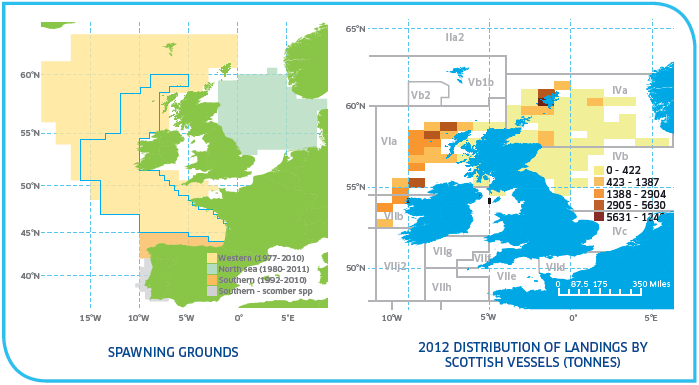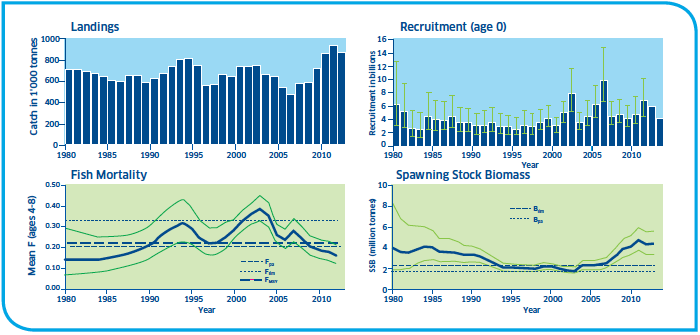Revised editon: Fish and Shellfish Stocks: 2014 Edition
Information on the state of fish and shellfish stocks of commercial importance to the Scottish fleet, inclduing Total Allowable Catches (TACs) for each stock.
Northeast Atlantic Mackerel Stocks
Mackerel (Scomber scombrus) is the most important pelagic species for the Scottish fishing industry. It is caught predominantly with pelagic trawl mainly in western waters and the North Sea.
2014 position : UK share 290,850 tonnes
Last Year : 160,118 tonnes
Landed into Scotland in 2012 : 61,972 tonnes
Value for 2012 : £59 million
Biology
The mackerel ( Scomberscombrus) caught by the Scottish pelagic fleet belong to two different stocks - the North Sea and the western. This separation is based on differences in the timing and the areas used for spawning. North Sea mackerel overwinter in the deep water to the east and north of Shetland and on the edge of the Norwegian Deep. In the springtime, they migrate south to spawn in the central part of the North Sea from May until July. The western mackerel stock is found near to the continental slope, over a vast area. These fish spawn between March and July, mainly to the south and west of the UK and Ireland. When spawning is finished, most of the spent fish move to the feeding grounds in the Norwegian Sea and the northern North Sea where they mix with the North Sea stock. Some western stock mackerel, predominantly small individuals, also enter the North Sea through the English Channel. The western stock mackerel travel long distances between the feeding grounds and the spawning areas. Over the past twenty years, the pattern of their southerly migration has changed dramatically in both timing and route. In the 1970s and 1980s this movement occurred in late summer and autumn with the fish passing through the relatively shallow waters of the Minch. Now the migration occurs gradually later in the year and is further offshore. The pattern of the return northerly journey, after spawning, has remained relatively constant. The boundaries of the spawning areas have also slowly changed, with an increase in spawning activity in the north of the area and to the west of the shelf edge.
By the time they reach three years old, most mackerel are mature. At one year old, only a small proportion of females are mature and able to spawn, while more than half can spawn at two years old. Female mackerel shed their eggs in about twenty separate batches over the course of a spawning season. An average-sized fish produces around 250,000 eggs. Juvenile mackerel grow quickly and can reach 22cm after one year and 30cm after two years.
The diet of mackerel can vary with the area and the season. By weight, almost half of the food consists of crustacea (shrimps). The remainder is made up of juvenile fish such as sandeel, herring and Norway pout.

ICES Advice on Management
Information Source:
ICES advice 2013:
http://www.ices.dk/sites/pub/Publication%20Reports/Advice/2013/2013/mac-nea.pdf
Updated ICES advice May 2014:
http://www.ices.dk/sites/pub/Publication%20Reports/Advice/2014/2014/mac-nea_update_2014.pdf
Quoted text in italics

State of stock and advice
- Catches of mackerel have been increasing since 2005 and have been around 900kt since 2010.
- The mackerel egg survey index show a doubling of the SSB since 2004 and a 30% increase from 2010 to 2013 (preliminary value).
- Recent landings have been stable and the stock appears to have increased.
- Discards are known to take place but cannot be quantified accurately; therefore total catches cannot be calculated.
- ICES provided and interim advice for 2014 (on the basis of the recent three year's landings): landings should be no more than 889,886 t. A benchmark was planned for 2014.
- The benchmark assessment was carried out in February 2014 considered alternative models. The assessment now uses an analytical age- based assessment model ( SAM) including new tuning series in addition to the egg survey index which provides an index of SSB.
Note: ICES has updated its Autumn 2013 advice and advises on the basis of the Norway, Faroe Islands, and EU management plan that catches in 2014 should be between 927 000 tonnes and 1 011 000 tonnes. ICES recommends that the management plan should be reviewed and possibly revised to reflect the new perception of the stock and the revised precautionary reference points (see table).
Management outcomes for 2014
The negotiations between the EU, Norway, Iceland and Faroe Islands over Northeast Atlantic Mackerel were ongoing until April 2014, due to the difficulty of reaching international agreement. The EU Total Allowable Catch for northeast mackerel was set at 537,240 tonnes. The UK quota was provisionally set at 290,850 tonnes.
MSY and precautionary approach reference points
(from advice released May 2014)
| Type | Value | |
|---|---|---|
| Management plan | SSB trigger | 2.2 million t |
| Ftarget | 0.20-0.22 | |
| MSY Approach | MSY Btrigger | 2.36 million t |
| FMSY | 0.25 | |
| Precautionary Approach | Blim | 1.84 million t |
| Bpa | 2.36 million t | |
| F | 0.39 | |
| Fpa | 0.26 |
Contact
There is a problem
Thanks for your feedback